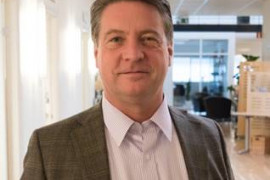Our streak of DHC Days interviews continue with Mårten Ahlm, from Alfa Laval.
Mårten is a seasoned marketing engineer, and has agreed to talk to us about how heat exchange shapes the industry on a daily basis.
We’d like to thank Mårten and the whole Alfa Laval team for this opportunity!
Mårten Ahlm: Heat exchange shapes the industry and its future
Can you introduce yourself and Alfa Laval to our readers? Who are your clients? What is your role?
Alfa Laval, founded in 1883 and still going strong, is a truly global engineering company supplying equipment and optimized solutions for basically all types of industries around the world based on our three main technologies and equipment: Heat transfer, Separation and Fluid Handling.
Within the DHC industry, Alfa Laval was a pioneer not only by developing heat exchangers – from the first plate heat exchangers to what they have become today, but also by developing and producing pre-fabricated substations since the 1960’s.
To my knowledge, there is no one even close to having such a long experience in this industry.
As for myself I’m a key account manager for our business working with Prefabricated substations tailor-made for the HVAC and District Energy industry.
We currently focus strongly on making sure that installations are energy efficient as it is the best way to make district energy cost efficient.
We’re here at DHC Days, one of the first events in France completely focused on district energy. How important are these types of events in shaping the future of the industry?
I believe it’s important for people in the industry to meet – both meetings between different types of actors (I’m thinking DHC operator/End Customer/Technology Supplier etc.) and with people who are in the same position as oneself, facing the same opportunities and challenges.
With this kind of events, you will most certainly find interesting discussions and possibilities to learn from people with different starting points or experiences.
District Energy has been said to be one of the pillars of the European energy transition. Would you still say the industry is in a good spot?
Yes, there are huge opportunities out there to be captured even though a lot seems to already have been done in many countries.
Sure, there are some challenges to be taken on, but I truly believe the industry is in a much better spot than it has been in years past.
What do you feel are the most important challenges for the industry to tackle in coming years? And in coming decades?
The number one challenge has been, and will probably always be heavy initial investment costs.
District energy is always completive with a long-term approach and as investments in energy supply typically have a quite long life time, it makes sense to consider the cost over long periods of time.
However, long-term cost calculations are not embraced as often as we’d like on new projects. When also taking the cost for Climate change and cost for adaptation of cities, regions and countries for low carbon emissions into consideration, DHC is even more competitive and can many times be the only true sustainable solution.
What do you find most interesting about the DHC industry?
For starters, the fact that DHC is a great the opportunity to positively influence a city or region from some many different perspectives.
In Sweden, we are usually talking about District Energy being a technology and industry with the capability to “carry the society”. It is a real foundation for the everyday life of the citizens and businesses.
You presented on intelligent heat exchangers for district heating during the event. Can you tell us more about it?
I focused on the influence of heat exchanger design and the importance of designing them right in all parts of the DHC system – in production plants, in DHC distribution and in end user systems to ensure optimal system efficiency.
Obviously, the whole chain needs to be as efficient as possible for DHC to be able to compete with other heating and cooling technologies.
In heating Production I focused on an innovative cooling technology, called LSV – Low Speed Ventilation, that we are supplying to Data Centers.
With this technology we will be able to increase heat recovery efficiency from Data Center Cooling installations by as much as 8%!
In the heating and cooling distribution I focused on the importance of achieving Lowest possible return temperature in networks and on the fact that heat exchangers dimensioning in substations can help achieve a difference of several degrees on return temperature.
We are, as the first supplier, actively promoting AHRI performance certified heat exchangers to really make sure that you get the thermal performance that you ask for in a substation.
This is especially important in District cooling where an under-dimensioned heat exchanger could easily increase the primary flow by 10-15%!
Heat demand/End user working with smart controls is the last chain to really make sure that low return temperature and highly efficient district heating are ensured.
With poor performance in controlling the heat demand for space heating and domestic hot water in each substation in a city, the whole system efficiency will suffer, leading to increased operational costs.
Alfa Laval is well known to work in a lot of industries, but can you explain exactly in which areas of district heating you’re most proficient?
Well, that was a tricky question to answer quickly as we are potentially involved in so many different parts, but I will give it a try.
As mentioned, we’ve been developing and supplying prefabricated substations for District Heating, Domestic Hot Water and District Cooling since the 1960’s.
We have a full range covering everything from standardized “flat stations/villa units” with a heating capacity of some few kW up to bespoke substations for large building complexes or industries with heating demand at several MW’s, and everything in-between.
We usually supply our substations completely plug-and-play ready including control equipment: just connect and you’re up and running.
For some markets we are supplying heat exchangers as components for substations that arebuilt on site when there is still a tradition to do so.
Alfa Laval is supplying really large heat exchangers to be installed as pressure breakers in district heating distribution grids with high level differences.
We also supply large heat exchangers to be installed inside boiler houses and heating plants.
Installations to recover heat from industries. One example is Kemira in Helsingborg where our heat exchangers are used to recover 22 MW of heating from a sulphuric acid production plant. The heat is then sold to the district heating customers in the city.
Plate heat exchangers from Alfa Laval are being used as evaporators and condensers in large scale heat pumps to extract energy from any source with lower temperature.
Data centers, industrial cooling plants and waste water treatment plants are some examples where they can be found.
Heat exchange and energy efficiency are bog topics right now in the industry. What does Alfa Laval have in store for the coming years?
As a technology supplier I hope and believe that the industry will focus even more on performance of the DHC installations to increase efficiency and decrease operational costs.
We are spending a lot on R&D, continuously improving the heat exchangers design so that we can be an active partner on this journey towards truly efficient district heating and cooling systems.
Supplying prefabricated substations optimized for high efficiency (including smart control equipment) is one clear example of products that we are supplying, and will continue to supply to the market.
But I would also promote the fact that we’ve learnt a lot about the industry throughout the years – We’re always open to share this knowledge with our customers and I’m hoping they will appreciate and take the opportunity to use all this application knowledge we have managed to build up during the years!







